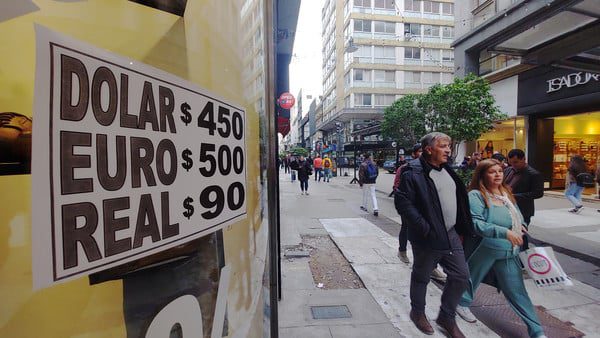Global Courant 2023-04-19 04:26:31
The market operated all day with the rumor that Antonio Aracre, adviser to the President, could replace Massa. In the end, Aracre ended up resigning his position. Strong rise of Cash With Liqui and the blue.
After the inflation record of 7.7% in March known last week, the markets reacted this Tuesday with the parallel dollars soaring to $426 in the case of cash with liquidity, falls in bonds of up to 2, 5% and the rise in country risk to 2,470 points. All in the midst of the weak performance of the soybean dollar and the displacement of the main presidential adviser, Antonio Aracre, after rumors about the eventual departure of Sergio Massa and his replacement, precisely, by Aracre.
The jump in alternative dollars -blue, counted with liquid or MEP- then reflected the nervousness caused in the operators by the possibility of Massa leaving and his replacement by Aracre. The rumors, promoted from the Casa Rosada, were deactivated at the close of the markets, when the exchange rate spike was already consummated. It was Aracre himself who announced via twitter that he was leaving his post.
The tensions overheated the blue from early on, which closed with a rise of $10 and reached $418 for the first time, in a day with little supply and dispersion in prices. Despite the 3% increase, in real terms it was below the average from 2021 to the present. If the dollar of the last two crises were updated, in October 2020 and July 2022, today it would be $741 and $573, in each case.
In the same way, the financial dollars also recorded new records, climbing up to $16, which took the CCL to $426, and the MEP to $409. The increases of up to 4% occurred in a round in which the Bank Central bought only US$1 million in the foreign exchange market and the flow of operations was limited in the bond market. In official dispatches they estimated no more than US$8 million, well below the US$100 million traded daily.
The rebound in parallel prices began last week and accelerated this Tuesday with the decline in Argentine bonds in dollars that are traded to buy MEP and CCL, an instrument used by companies to become dollarized. “A little bit of fear, not panic, makes bonds go lower and the dollar go up,” one trader said. Thus, the gap between the financial dollar and the official dollar rose to 96%.
Seeking to capitalize on the provincial victories in Neuquén and Río Negro, Sergio Massa appeared this Tuesday with the elected governors Rolando Figueroa and Alberto Weretilneck.
“The acceleration of parallel dollars always has several factors, but we also have to highlight the role of expectations, as long as the Central Bank cannot rebuild reserves, the possibility of a devaluation jump remains very present and causes savers and companies to hedge. A situation is reinforced by the acceleration of inflation and the loss of value of the peso,” said Claudio Caprarulo, director of Analytica.
The economic team associated the tremors with “hot weather” due to the search for coverage in the face of inflationary expectations and the version of a possible landing of Aracre in the Ministry of Economy. “They installed the noise of the departure of Massa and the entry of Aracre and the market reacted,” they explained from the Palacio de Hacienda. “A lot of noise, few operations,” they said in another official dispatch.
Exchange rate pressures intensified despite the UBA ruling published on Monday that would unlock the exchange of bonds in dollars with ANSES and would allow the exchange rate gap to be contained. Although the house of studies warned about a greater indebtedness, Massa interpreted the pronouncement as a nod to advance in the measure. But the decree still needs to be regulated, which delays the intervention.
“They are going to use the ruling to intervene in the gap and finance the treasury, to the extent that they need it with auctions because they cannot be turned over to the secondary market in a colossal way because they would destroy parities,” said economist Salvador Vitelli. And he added: “With the proceeds from the sale of bonds, they are going to issue dual bonds (in pesos), this generates pressure and uncertainty in the market.”
Vitelli thus pointed to the rumors of deposit pesification that circulated at the beginning of the launch of the debt swap and which, in his opinion, led to the outflow of deposits in the private sector. According to his data, the banks requested US$36 million in bills this Tuesday and the trickle in the year would add up to US$570 million. But in a bank they reported that the orders are for replacement, not for withdrawals.
“There was a small departure before Easter, but now everything is stabilized and nothing is happening,” said a manager. However, he acknowledged that the policy “added to the noise” on Tuesday.
After traveling to Washington to negotiate new relief with the IMF, Massa continues to struggle to stabilize the economy. ”Although prices will increase the dollarization of portfolios and there will be greater pressure in the third quarter due to the elections and the greater difficulty in liquidating foreign currency, the government has tools to control the gap,” said Santiago Manoukian, head of research from Ecolatina.
However, he estimated that “there will be pressure on financial dollars, it is logical that they will follow inflation more after falling behind last year.”







